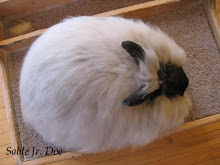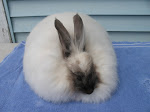This first bunch is Pascha's litter, with a few of Neva's babies fostered in (the REW and Sable are Pascha's, and the Fawn is Neva's). There are more babies in this litter hiding on the other side of the cage, but they did not see fit to squeeze into the picture:).

This is a close-up picture of one of the Fawns scratching itself:)
This is Evariste lounging with some of the babies from her litter. Shown here are 2 REWs, but there is also a Sable and Pearl in the bunch (sired by Pierre).

This is a (3 week old) Pearl from Juno's litter. Another very dark bunny. It will probably be very nicely shaded when the wool comes in.
And this is a close-up of 2 of the babies in Oomi's litter (with Oomi's nose stuck in on the left). A Pearl and a REW--again:).

And this is Echo's big litter, with 9 remaining from the original 13. Needless to say this cage is CRAMMED with that many babies and one doe in a 30 X36 inch space, but tomorrow is the 6 week birthday mark, so three of them will be removed first thing tomorrow morning. This is one of the Pearls in the batch. There are also 4 Sables, and a REW.

And this is a shot I tried to take of the Sable bunnies from the same litter, but Mom (who doesn't like me much even on her best day, LOL) has decided that there is NO way I will be taking any unauthorized photographs of her babies today or anyday, as long as she has even one thing to say about it. Look at that expression! This is Echo in a nutshell:).

And finally, here are 2 pics of Giacomo and Arcadia just before their haircuts last week. At only 5 months it was a little early to clip the babies out of Juno's litter, but given the weather lately and the fact that they were starting to look miserable, I decided not to wait. With a little luck all of the babies from this litter will be in coat and ready for the PA Convention.

And this is Echo's big litter, with 9 remaining from the original 13. Needless to say this cage is CRAMMED with that many babies and one doe in a 30 X36 inch space, but tomorrow is the 6 week birthday mark, so three of them will be removed first thing tomorrow morning. This is one of the Pearls in the batch. There are also 4 Sables, and a REW.

And this is a shot I tried to take of the Sable bunnies from the same litter, but Mom (who doesn't like me much even on her best day, LOL) has decided that there is NO way I will be taking any unauthorized photographs of her babies today or anyday, as long as she has even one thing to say about it. Look at that expression! This is Echo in a nutshell:).

And finally, here are 2 pics of Giacomo and Arcadia just before their haircuts last week. At only 5 months it was a little early to clip the babies out of Juno's litter, but given the weather lately and the fact that they were starting to look miserable, I decided not to wait. With a little luck all of the babies from this litter will be in coat and ready for the PA Convention.













































